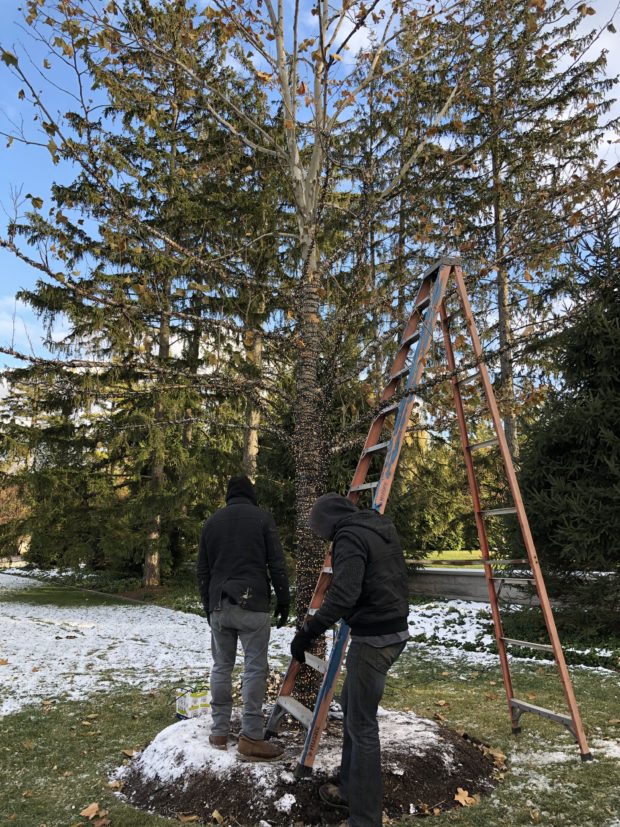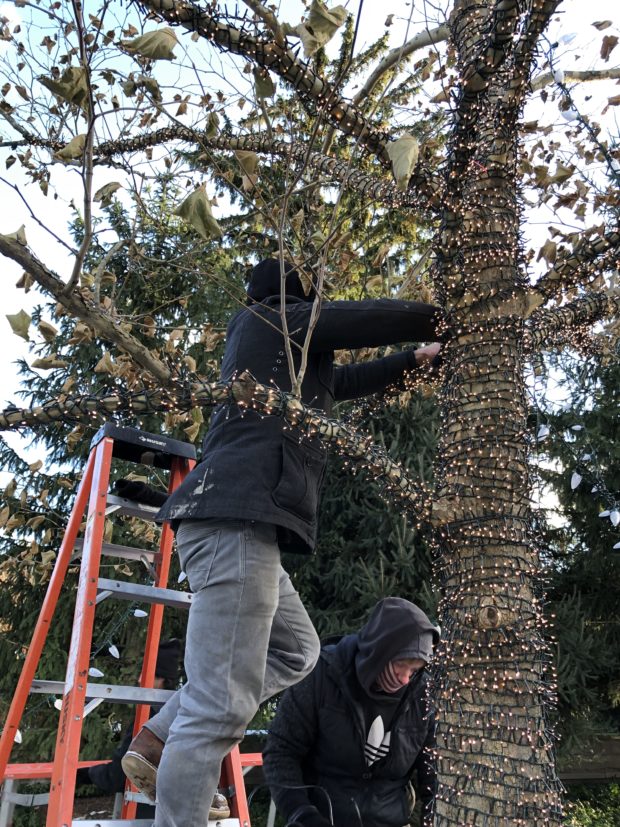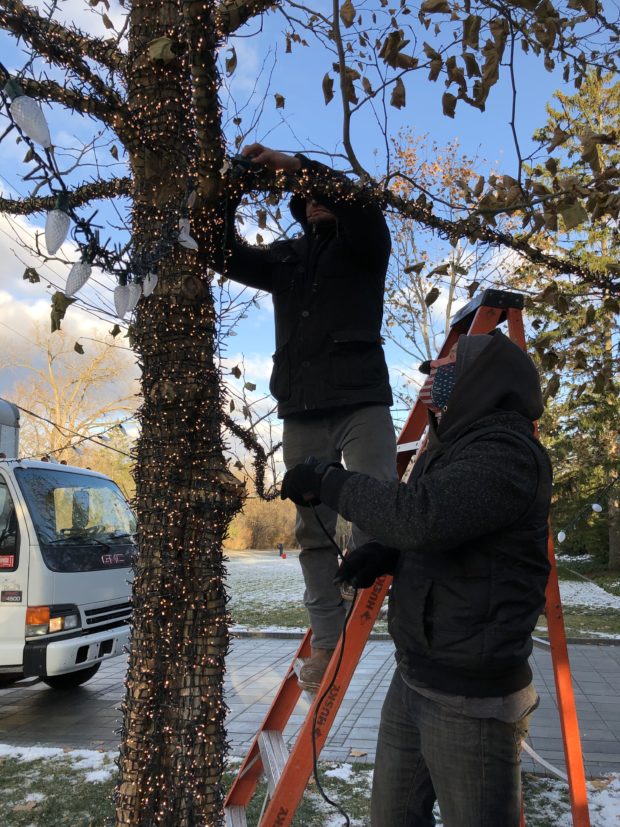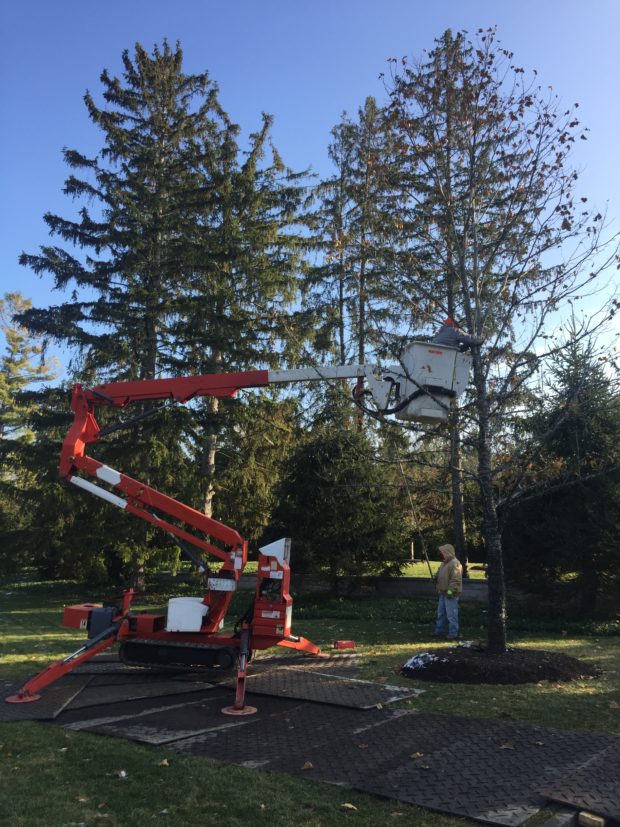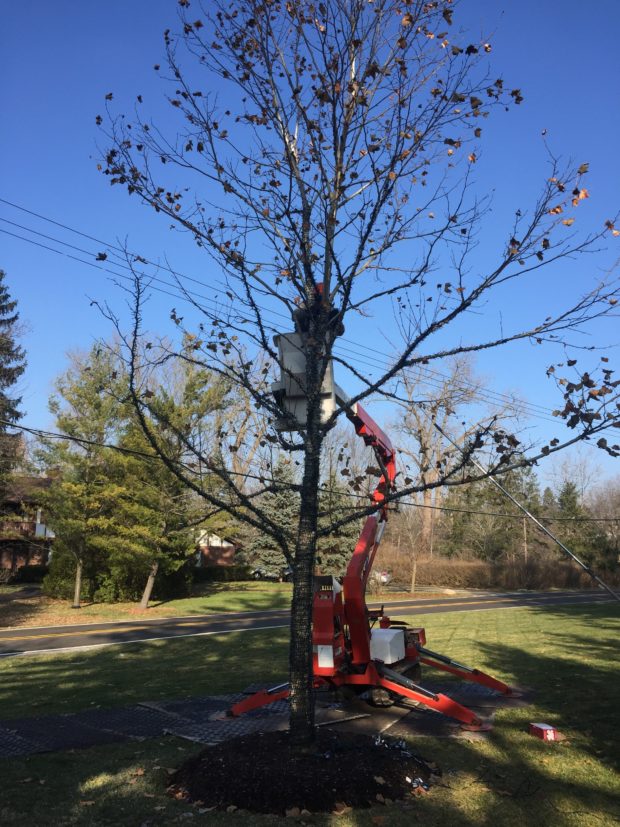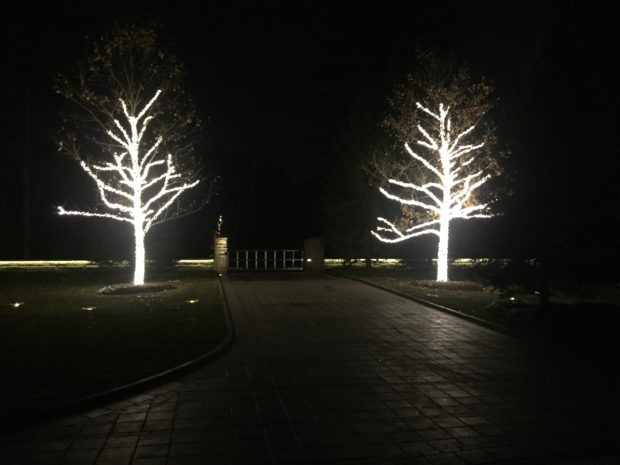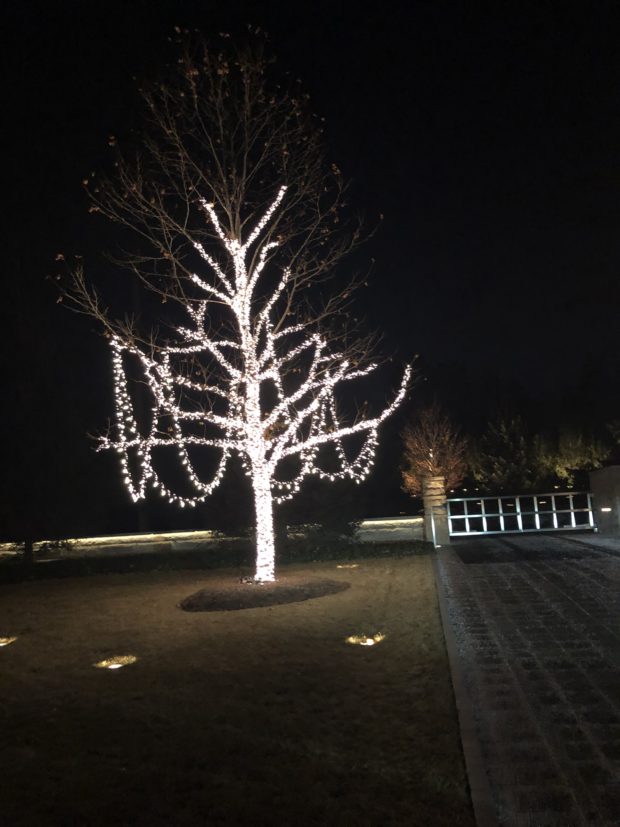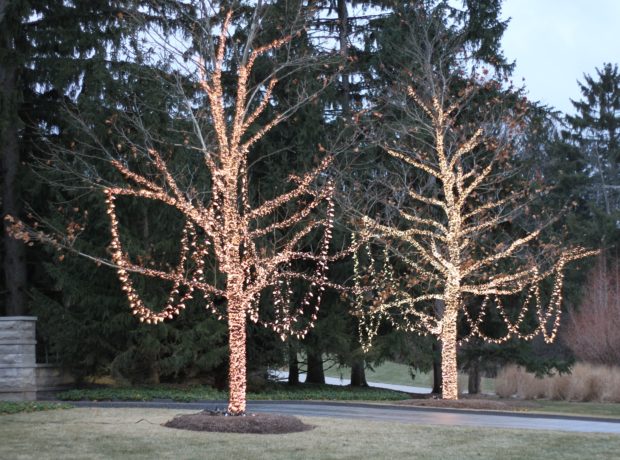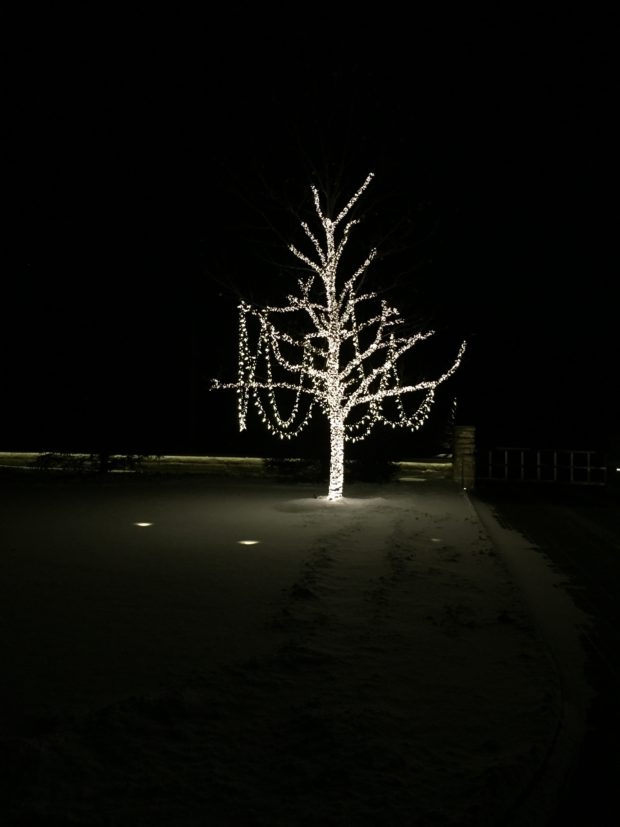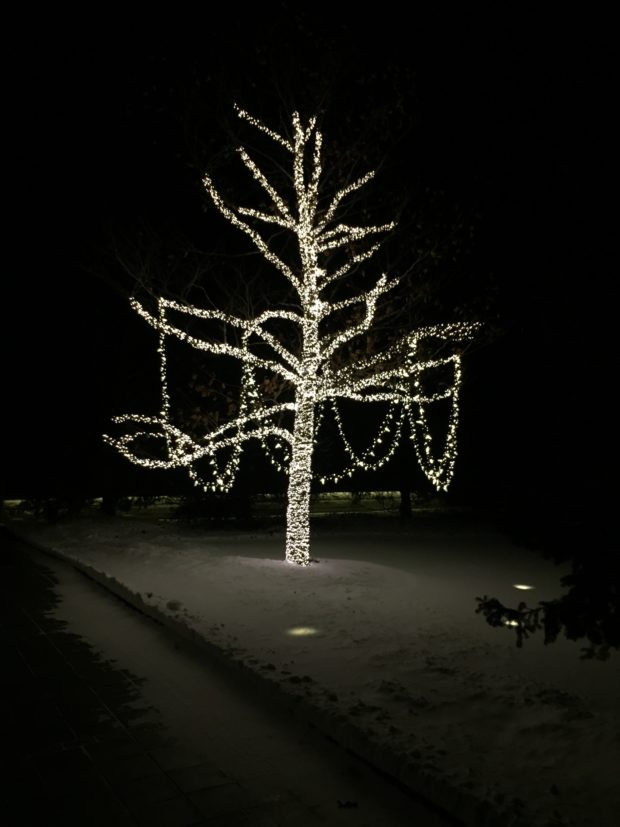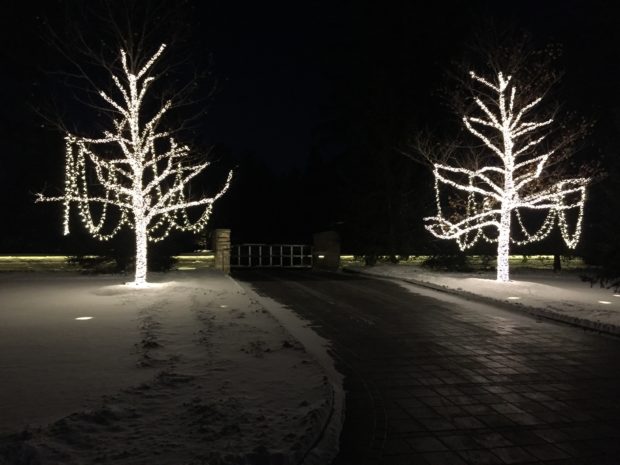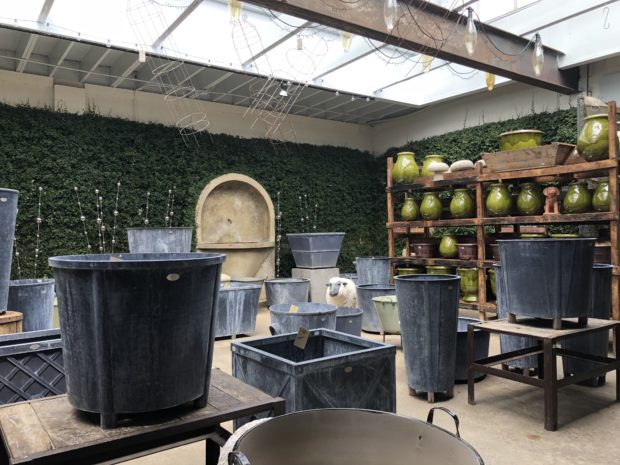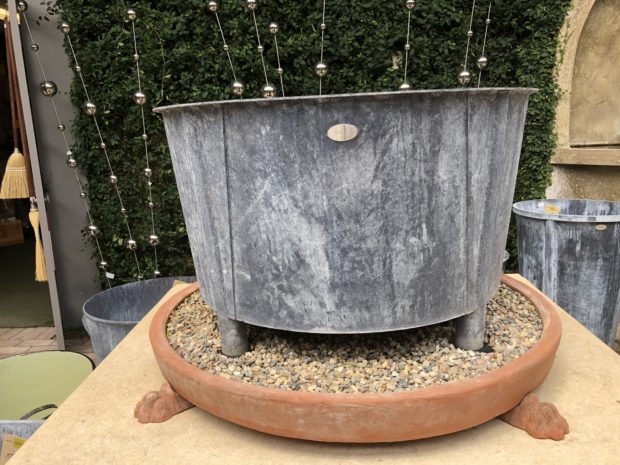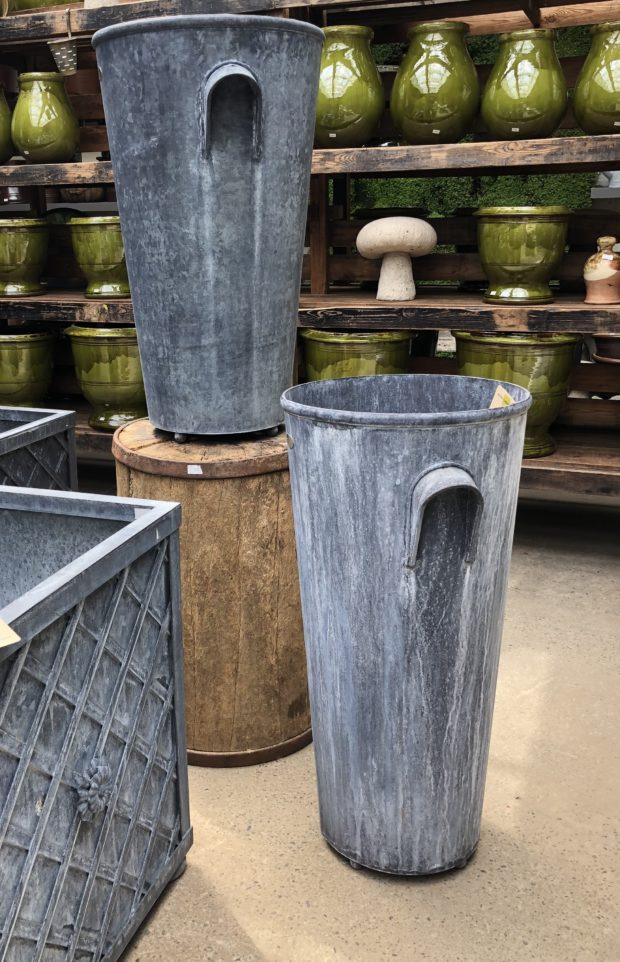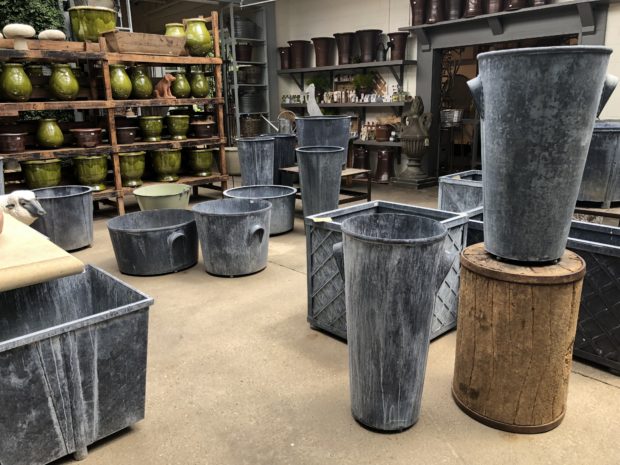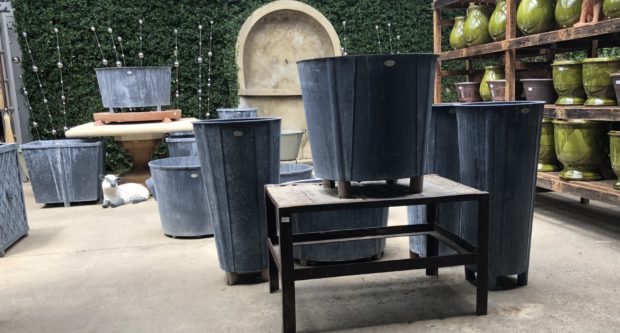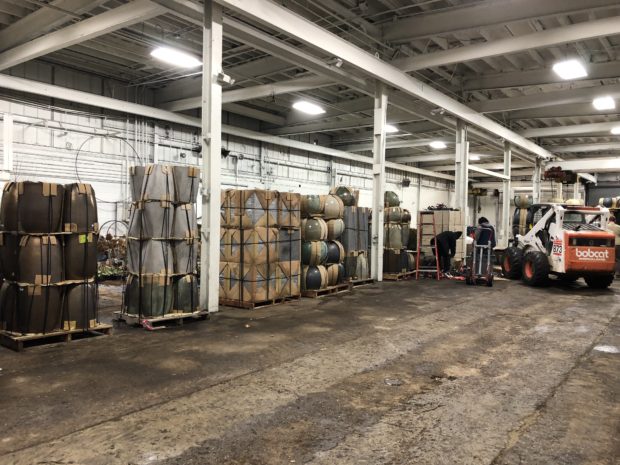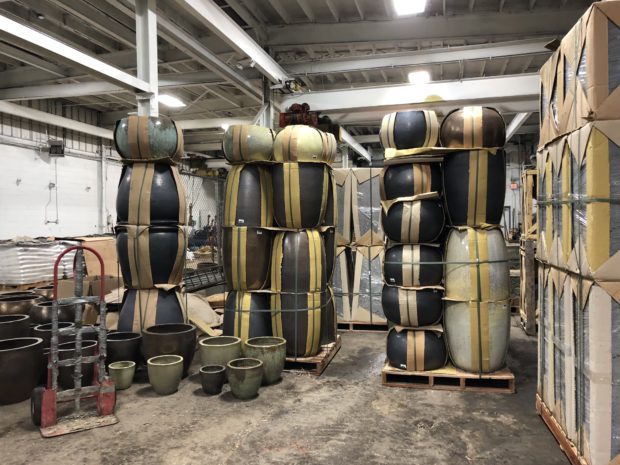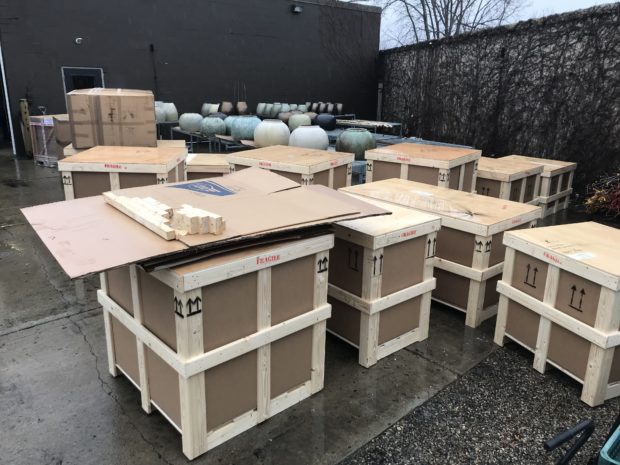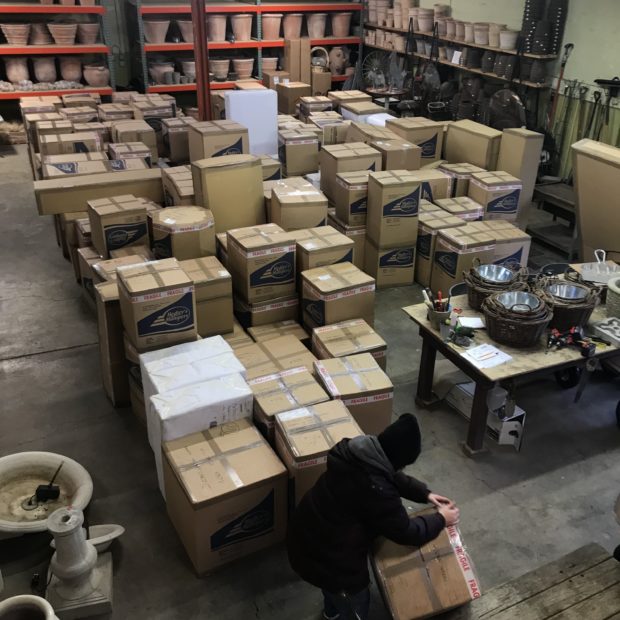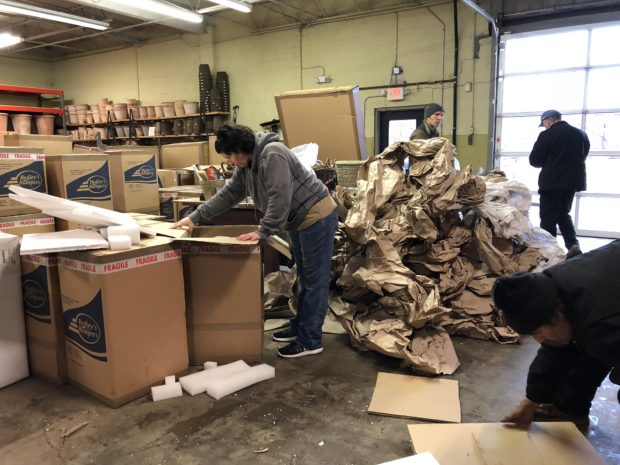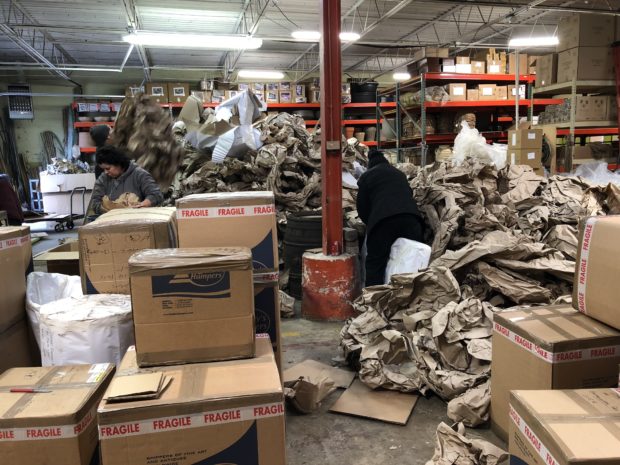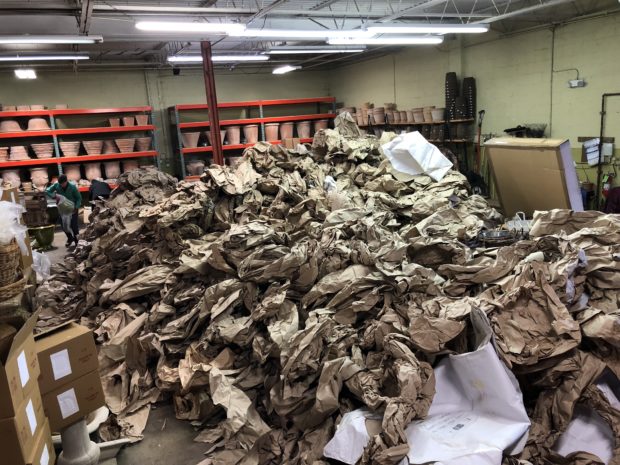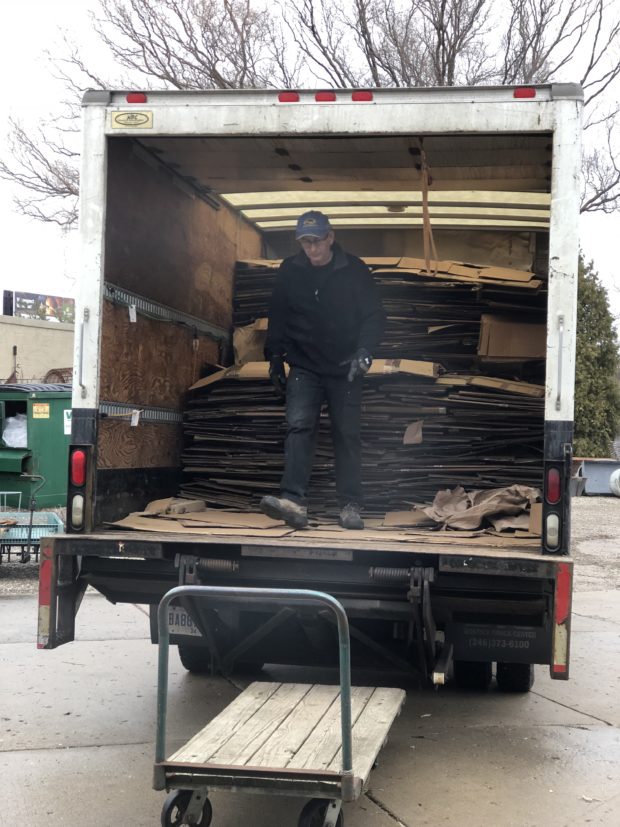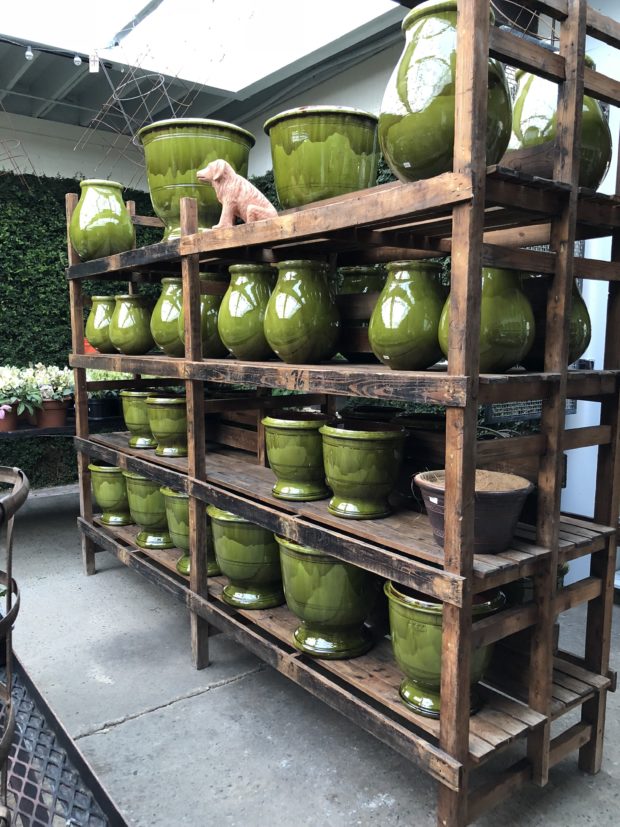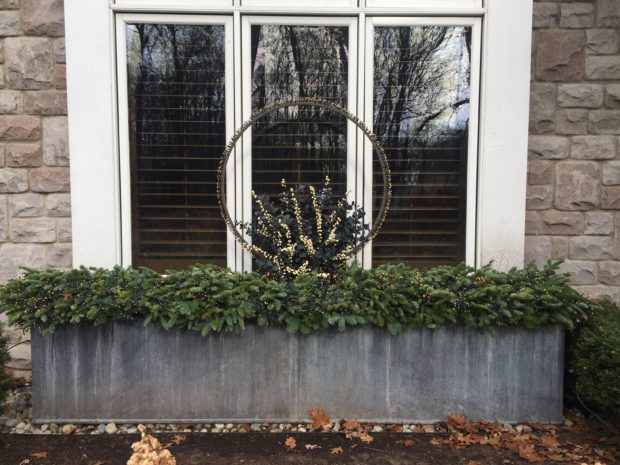 If my memory serves me correctly, it was 7 years ago that Rob wound strand lighting around a few vintage wagon wheels, and suspended them from the ceiling of the shop for the holidays. I doubt they were on display for a week before the lot of them was purchased by an enthusiastic client. Over the next several years he designed and redesigned custom made steel circles, carefully engineered and fabricated to accept lights that would hang from a stout tree branch. Of course the light cord was disguised by a substantial hank of jute. An extension cord run up the trunk of the tree would connect to the plug at the top of the branch. They were so beautiful. Arresting. A circle of light with with no visible means of support shining in the winter night. What could be more simple and more joyful? This version of winter lighting is spare and eminently satisfying, both in its shape, and installation. Tie the ring to a substantial branch, and plug it in. Winter gardening in my zone is all about the quality of the light. Not only the body benefits from vitamin D.
If my memory serves me correctly, it was 7 years ago that Rob wound strand lighting around a few vintage wagon wheels, and suspended them from the ceiling of the shop for the holidays. I doubt they were on display for a week before the lot of them was purchased by an enthusiastic client. Over the next several years he designed and redesigned custom made steel circles, carefully engineered and fabricated to accept lights that would hang from a stout tree branch. Of course the light cord was disguised by a substantial hank of jute. An extension cord run up the trunk of the tree would connect to the plug at the top of the branch. They were so beautiful. Arresting. A circle of light with with no visible means of support shining in the winter night. What could be more simple and more joyful? This version of winter lighting is spare and eminently satisfying, both in its shape, and installation. Tie the ring to a substantial branch, and plug it in. Winter gardening in my zone is all about the quality of the light. Not only the body benefits from vitamin D.
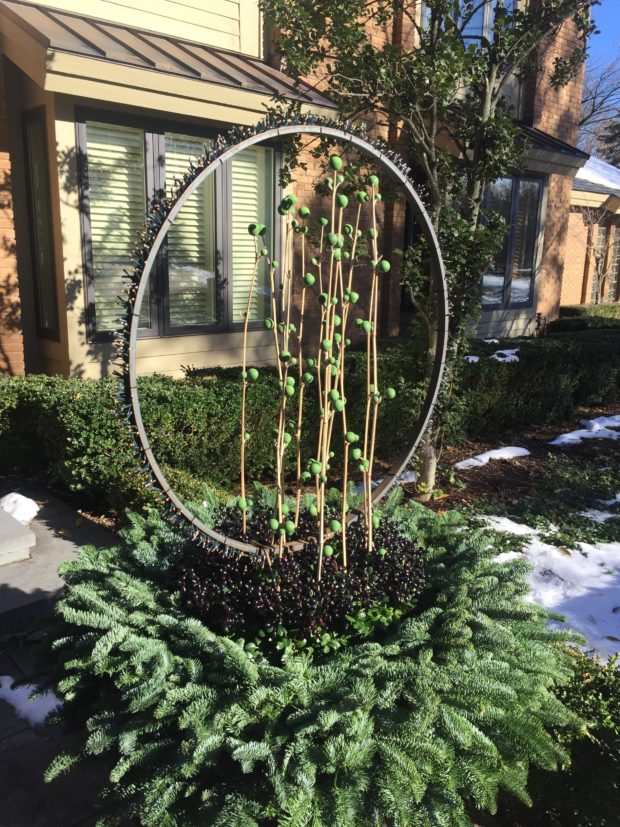 A later design of Rob’s included a four pronged mechanism that would enable the light rings to be set securely into the ground, or the soil in a container. This revolutionized my winter container design. How I love incorporating lighting in winter pots. The ring set in the pot encouraged a whole new avenue of design. A few years ago, he suggested that his lighted circles had run their course, and perhaps he should move on to another design or shape. I was incredulous. Those light circles had enchanted clients both near and far. A restaurant in Newfoundland Canada bought 7 of the largest size, and five of the medium size-for their outdoor dining space. They, and countless other design and private clients both local and nation wide have spoken for those lighted circles. Year after year. I suspect I will never tire of them.
A later design of Rob’s included a four pronged mechanism that would enable the light rings to be set securely into the ground, or the soil in a container. This revolutionized my winter container design. How I love incorporating lighting in winter pots. The ring set in the pot encouraged a whole new avenue of design. A few years ago, he suggested that his lighted circles had run their course, and perhaps he should move on to another design or shape. I was incredulous. Those light circles had enchanted clients both near and far. A restaurant in Newfoundland Canada bought 7 of the largest size, and five of the medium size-for their outdoor dining space. They, and countless other design and private clients both local and nation wide have spoken for those lighted circles. Year after year. I suspect I will never tire of them.
 A circle is a simple shape. It is a closed and regular curve that divides a plane into two regions. The interior, and the exterior. This from Wikipedia. The interior of this light ring is inhabited by a brightly burning light burst. The exterior is the greater landscape. The circle here is a means by which to focus on a particular albeit temporary feature-the light. A circle has no beginning or end. It’s recognizable symmetry is a source of visual delight in nature, and in designed spaces of all kinds. The circle is the basis of all kinds of graphic design, of which the polka dot dress is a familiar example. The circle was also the basis for the wheel, which makes all manner of modern machinery possible. It is interesting to note that all circles are the same, except for their diameter, and the width of their border. Circles of different materials and sizes that intersect create other shapes.
A circle is a simple shape. It is a closed and regular curve that divides a plane into two regions. The interior, and the exterior. This from Wikipedia. The interior of this light ring is inhabited by a brightly burning light burst. The exterior is the greater landscape. The circle here is a means by which to focus on a particular albeit temporary feature-the light. A circle has no beginning or end. It’s recognizable symmetry is a source of visual delight in nature, and in designed spaces of all kinds. The circle is the basis of all kinds of graphic design, of which the polka dot dress is a familiar example. The circle was also the basis for the wheel, which makes all manner of modern machinery possible. It is interesting to note that all circles are the same, except for their diameter, and the width of their border. Circles of different materials and sizes that intersect create other shapes.
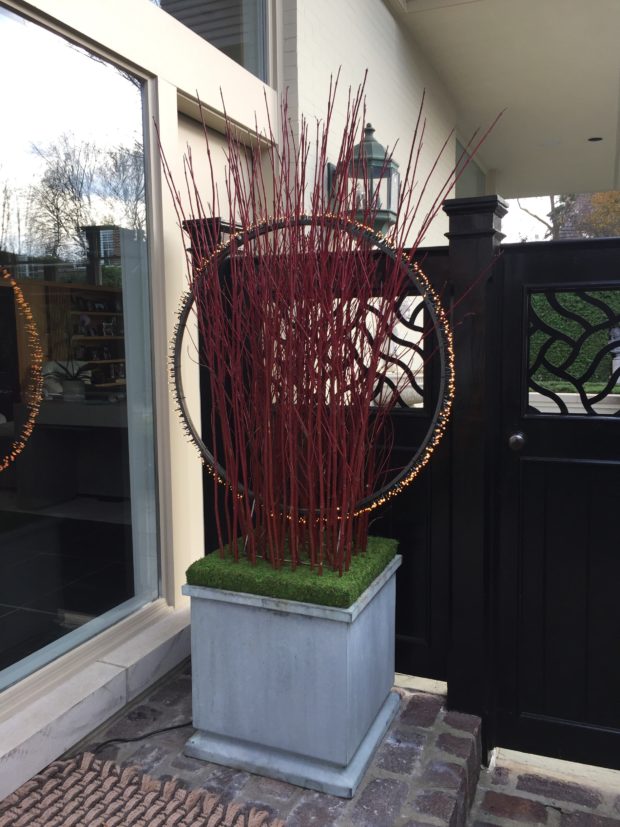 The space between 2 endpoints marked on a circle is called a chord. I do not know the history of this definition, but I can attest to the fact that landscape designs that strike a chord with a client or a viewer are engaging, and emotionally satisfying. A circle is a complete entity unto itself. A circle comes standard issue with a sense of completeness. As in the rotation of the seasons. Though I may not have so many words to put to the experience, circular shapes and spaces evoke a response. In laying out a curved area in the landscape, I start with a chord-or a section of a circle. This is fairly easy to do, with a bamboo stake and string. Finding the center of that circle which will produce the desired chord may take a while, but eventually there will be consistently curving line.
The space between 2 endpoints marked on a circle is called a chord. I do not know the history of this definition, but I can attest to the fact that landscape designs that strike a chord with a client or a viewer are engaging, and emotionally satisfying. A circle is a complete entity unto itself. A circle comes standard issue with a sense of completeness. As in the rotation of the seasons. Though I may not have so many words to put to the experience, circular shapes and spaces evoke a response. In laying out a curved area in the landscape, I start with a chord-or a section of a circle. This is fairly easy to do, with a bamboo stake and string. Finding the center of that circle which will produce the desired chord may take a while, but eventually there will be consistently curving line.
 Taking the time to draw the chord on the ground helps to eliminate the squiggles. By squiggles, I mean those bed lines that curve in and out in rapid succession around this shrub and that tree – without an overall sweeping curve that is visually cohesive. It helps to provide focus to what landscape elements belong in the exterior of that partial circle, and what belongs outside. The light ring pictured above is made from steel, but that steel does not need to be that thick. Steel rolled into a circular shape is as stable and strong physically as it appears to be. The ring celebrates the centerpiece. The pussy willow that pushes past the edge of the circle creates a relationship between the geometry of one element and the natural form of another. Both materials are stronger visually given the form of the other. The ring also compliments the rectangular geometry of the planter box, and narrower and wider rectangle of the greens. The composition without the ring would be fine. But its presence completes the composition in a way that organizes all of the other shapes and materials.
Taking the time to draw the chord on the ground helps to eliminate the squiggles. By squiggles, I mean those bed lines that curve in and out in rapid succession around this shrub and that tree – without an overall sweeping curve that is visually cohesive. It helps to provide focus to what landscape elements belong in the exterior of that partial circle, and what belongs outside. The light ring pictured above is made from steel, but that steel does not need to be that thick. Steel rolled into a circular shape is as stable and strong physically as it appears to be. The ring celebrates the centerpiece. The pussy willow that pushes past the edge of the circle creates a relationship between the geometry of one element and the natural form of another. Both materials are stronger visually given the form of the other. The ring also compliments the rectangular geometry of the planter box, and narrower and wider rectangle of the greens. The composition without the ring would be fine. But its presence completes the composition in a way that organizes all of the other shapes and materials.
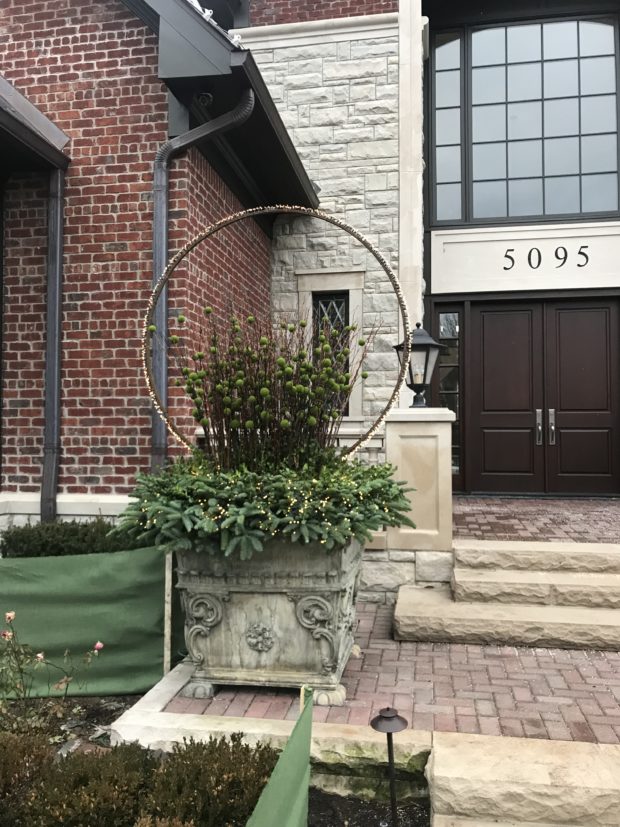 Rob has the rings made in a variety of sizes, from two feet in diameter up to seven feet. The ring pictures above is five feet in diameter – a good size considering the size of this pot. The first rings were strung with strands of incandescent twinkle lights that had brown cords. Now we use only LED lights, for longevity’s sake. The lights go around the outside of the ring, and each bulb faces out. We ship them out with and without lights, and we have made them in custom sizes for a particular application.
Rob has the rings made in a variety of sizes, from two feet in diameter up to seven feet. The ring pictures above is five feet in diameter – a good size considering the size of this pot. The first rings were strung with strands of incandescent twinkle lights that had brown cords. Now we use only LED lights, for longevity’s sake. The lights go around the outside of the ring, and each bulb faces out. We ship them out with and without lights, and we have made them in custom sizes for a particular application.
 This ring is hung high in a window, so it can easily be seen from the street.
This ring is hung high in a window, so it can easily be seen from the street.
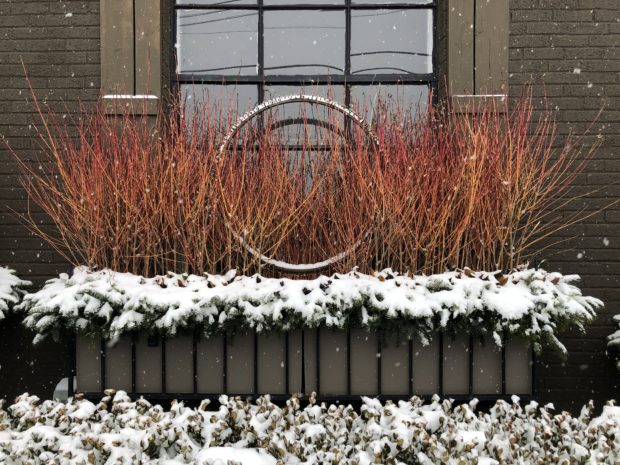 Led lights produce little in the way of heat, so the snow has collected on the inside lower edge of the ring pictured above. The contrast of the snow and the light provides a little welcome interest to the winter landscape, even during the day.
Led lights produce little in the way of heat, so the snow has collected on the inside lower edge of the ring pictured above. The contrast of the snow and the light provides a little welcome interest to the winter landscape, even during the day.
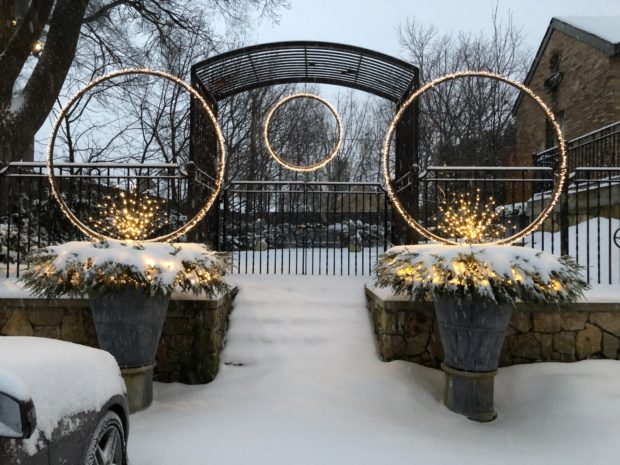 This is my first year with light rings at home. I drive up to them, and I can see them from the deck above.
This is my first year with light rings at home. I drive up to them, and I can see them from the deck above.
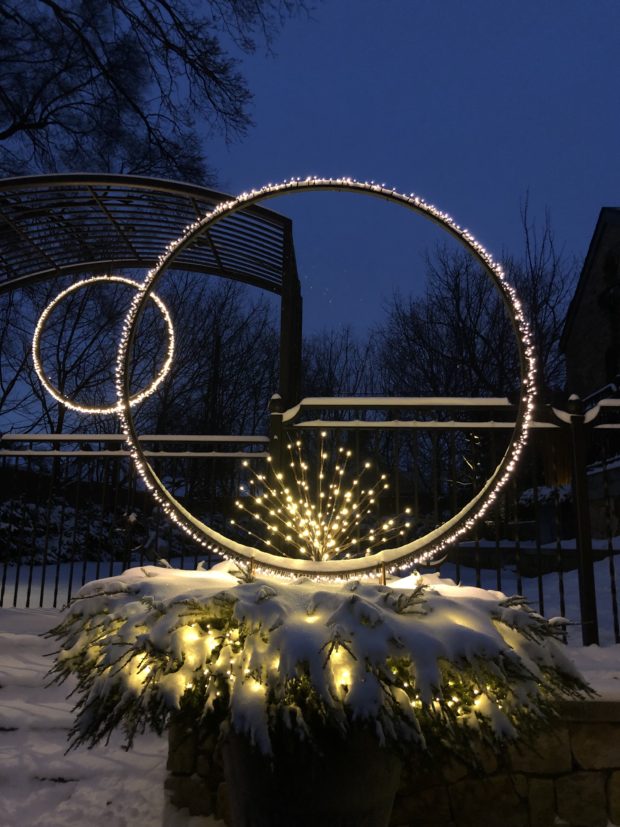 The 6 inches of snow that fell yesterday just made them look better.
The 6 inches of snow that fell yesterday just made them look better.
 H sent me these pictures of her winter boxes last night. She is enjoying hers too.
H sent me these pictures of her winter boxes last night. She is enjoying hers too.
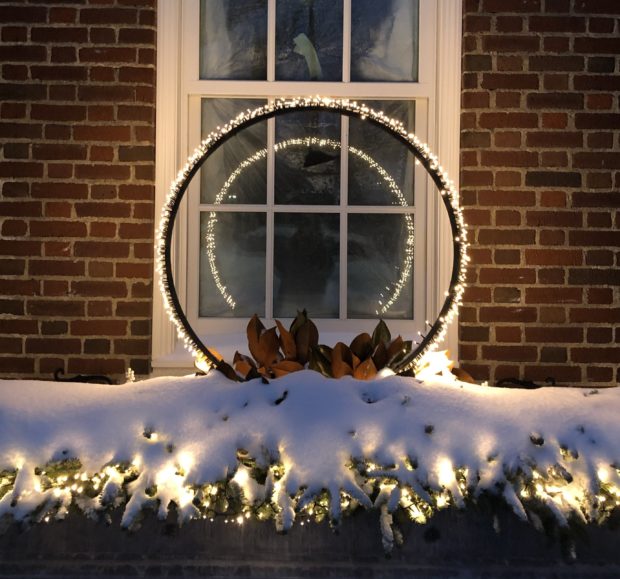 I have indeed talked before about these rings recently, but the fact is we are looking at more weather that looks just like this for quite a while yet. These lighted circles make it easier to bear with the winter.
I have indeed talked before about these rings recently, but the fact is we are looking at more weather that looks just like this for quite a while yet. These lighted circles make it easier to bear with the winter.
